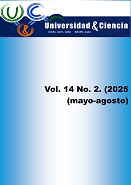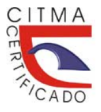Enhancing sweet potato crop irrigation sustainability through repurposed treated urban wastewater
DOI:
https://doi.org/10.5281/zenodo.16413193Palavras-chave:
agricultural yield, effluent application, soil nutrients, wastewater repurposingResumo
Introduction: This study, situated at Morón City's stabilization pond in Cuba's Ciego de Avila province. Objective: the viability of utilizing treated urban wastewater for sweet potato crop irrigation. Method: throgh the traditional furrow irrigation technique and the evaluation of the effects on the soil and the crop. Results: the research conducted 17 irrigation events, where 14 used effluents and 3 sourced groundwater. Additionally, five rainfall events complemented the irrigation sessions. Throughout the crop's growth cycle, it received a cumulative 5,906.91 m3 of water from the effluent application, supplemented by 2,109.61 m3 from groundwater and 2,272.50 m3 from effective precipitation. Remarkably, the commercial agricultural yield achieved an impressive 24.17 t·ha-1, well within the potential yield range for this clone. Assessment of the applied effluent revealed an electrical conductivity of 952.0 µS·cm-1 and a pH of 5.6, falling within permissible levels for agricultural crop development. Wastewater irrigation substantially augmented soil nutrient content, boosting P2O5 by 2.67 mg·100g-1, K2O by 15.05 mg·100g-1, and organic matter by 1.88 %. This corresponded to a significant nutrient influx, introducing 242.36 kg of P2O5 and 1,366.13 kg of K2O into the soil. Conclusion: This study unequivocally demonstrates the affirmative impacts of employing urban wastewater on soil quality and crop productivity. Not only did it elevate agricultural yield, but it also enriched the soil with vital nutrients while circumventing phytosanitary issues. By exemplifying sustainable water management and urban hydrology principles in agricultural practices, this research underlines their potential in fostering sustainable agriculture.
Downloads
Referências
Acosta, Z., Arechabala, M., Borroto, E., Díaz, R., Hernández, L., Mansur, A., Melero, N., Pell, I., Rodríguez, B. yTorres, O. (2024). Central history and heritage of Cuba. Digital CSIC Open Science. https://digital.csic.es/handle/10261/341859
Aguilar, J. y Cubas, N. (2021). Soil contamination due to the use of wastewater. Journal of Research in Agricultural Sciences and Veterinary Medicine, 5(14), 132-144. https://doi.org/10.33996/revistaalfa.v5i14.104
Casanovas, C., Villar, A., Alvares, A. y Avilleira, I. (2022). Assessment of Cuban food security based on the agricultural surface area exploited and agricultural yields. Journal of University and Society, 14(5), 304-314. http://scielo.sld.cu/scielo.pdp?script=sci-arttext&pid=S2218-86202022000500304&Ing=es&tIng=pt
Castillo, J. G., Balarezo, L. D. y Vinces, M. B. (2020). Alternatives for stabilizing sludge from wastewater treatment plants. Journal of RIEMAT, 5(1), 1-4. https://revistas.utm.edu.ec/index.php/Riemat/article/view/2499
Díaz, J. A. (2018). Water in Cuba: a challenge to sustainability. Journal of Hydraulic and Environmental Engineering, 39(2), 46-59. https://scielo.sld.cu/scielo.php?script=sci-arttext&pid=S1680-03382018000200004&Ing=pt
Espinosa, A., Ruiz, L., Rivera, R. y Espinosa, E. (2015). Effect of Nitrogen and arbuscular mycorrhizal fungi on two commercial clones of sweet potato on a carbonated loose brown soil. Journal of Agricultural Center, 42(2), 39-46.
https://www.researchgate.net/profile/Ramon-Rivera-6/publication/279516461
Food and Agriculture Organization of the United Nations [FAO]. (2017). Water reuse for agriculture in Latin America and the Caribbean. States, principles and needs. https://www.fao/3/a-i7748s
García, M., Luna, J., Gallegos, M., Preciado, P., Cervantes, M. y González, U. (2020). Impact of wastewater on some properties and accumulation of heavy metals in the soil. Journal of Terra Latinamerican, 38(4), 907-916. https://doi.org/10.28940/terra.v38i4.556
González, L., Carrillo, F., Acosta, M., Baéz, A., Espitia, E., Etchevers, J. y Paz, F. (2022). Mexican experience in the implementation of the Roth C-26.3 model of soil organic carbon dynamics: scope and limitations. Journal of Terra Latinamerican, 40, 1-23. https://doi.org/10.28940/terra.v40i0.1386
Hernández, L., Santana, Y., Carrodeguas, S., Del Busto, A., Dovales, A., Lugo, B., Pita, A. y Hernández, R. (2018). Agronomic response of sweet potato clones and damage by sweet potato weed in Pinar del Río. Journal of Agricultural Center, 45(4), 91-94. http://scielo.sld.cu/scielo.pdp?script=sci-arttext&pid=S0253-57852018000400091&Ing=es&tIng=en
Humanante, J. J., Moreno, L. C., Grijalva, A., Saldoya, R. W. y Suarez, J. A. (2022). Removal efficiency and impact of the wastewater treatment system in the urban and rural sectors of the Province of Santa Elena. Journal of Manglar 19(2): 177-187. http://doi.org/10.17268/manglar.2022.022
Rodríguez, D., Morales, A. L., Morales, A., Herrera, J. A. y Díaz, A. (2017). Morpho-agronomic and physiological evaluation of six improved genotypes of sweet potato (Ipomoea batatas (L.) Lam.). Journal of Tropical Agriculture, 3(1), 20-30. http://ojs.inivit.cu/index.php?journal=inivit&page=rt&op=printerFriendly&path%5B%5D=63&path%5B%5D=0
World Health Organization [WHO]. (2019). Water for human consumption. https://www.who.int/es/news-room/fact-sheets/detail/drinking-water
Downloads
Publicado
Como Citar
Edição
Seção
Licença
Copyright (c) 2025 Universidad & ciencia

Este trabalho está licenciado sob uma licença Creative Commons Attribution-NonCommercial-ShareAlike 4.0 International License.





















